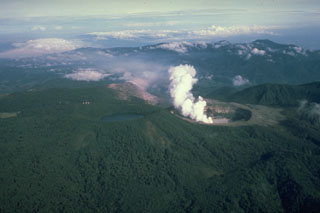Report on Poas (Costa Rica) — 30 April-6 May 2025
Smithsonian Institution / US Geological Survey
Weekly Volcanic Activity Report, 30 April-6 May 2025
Managing Editor: Sally Sennert.
Please cite this report as:
Global Volcanism Program, 2025. Report on Poas (Costa Rica) (Sennert, S, ed.). Weekly Volcanic Activity Report, 30 April-6 May 2025. Smithsonian Institution and US Geological Survey.
Poas
Costa Rica
10.2°N, 84.233°W; summit elev. 2697 m
All times are local (unless otherwise noted)
The Observatorio Vulcanológico y Sismológico de Costa Rica-Universidad Nacional (OVSICORI-UNA) reported continuous gas-and-steam emissions, ash-and-gas emissions sometimes lasting hours, and explosions at Poás during 30 April-6 May. Inflation continued to be detected. Seismic and infrasound sensors recorded seismic-acoustic signals indicating fluctuating eruptive activity with frequent more intense eruptive pulses. The webcams recorded the emissions and incandescence at the vents.
During 29-30 April ash-and-gas plumes rose a few hundred meters above the crater rim and drifted SW, causing significant ashfall in the Sarchi area (18 km SW). The density of the ash content was higher in the morning and early afternoon on 30 April. Around 0300 on 1 May a team conducted a drone overflight and measured a temperature of 180 degrees Celsius, indicating no lava near the surface. A more intense eruptive pulse at 0315 sent ash-and-gas 500 m above the crater rim. Burning molten sulfur at the vents was visible at night during 1-2 May and continued to be visible during dark hours the rest of the week. Beginning at 0500 on 2 May ash emissions were continuous for at least three hours, producing a black-and-white plume that rose less than 1 km above the crater rim and drifted W. Several eruptive pulses with white-and-gray plumes were recorded during the day, notably at 1520, and drifted W. Ashfall was reported in Grecia and Naranjo, and residents observed rising ash-laden water levels in the Desague (W) and Anonos (N) rivers. Incandescent material was ejected mainly to the W and deposited on the crater floor. Sulfur dioxide emissions averaged 612 tons per day (t/d). Ashfall was reported in San Juan de Grecia (17 km SW), Montes de Oca (37 km SE), and San José (34 km SE), and a sulfur odor was detected in Alajuela (San Ramón, 29 km WSW).
Overnight during 2-3 May incandescence from sulfur combustion suggested temperatures around 160 degrees Celsius. Eruptive pulses at 0300 and 0812 on 3 May generated ash-and-gas plumes that rose 500 m above the crater rim and drifted W. Sulfur dioxide emissions detected in satellite data were 508 t/d. Eruptive activity decreased during 3-4 May, characterized by vigorous white gas-and-steam plumes with less ash content. Sulfur combustion produced intense incandescence overnight. The ash content in the emissions increased at around 1100 and caused a darker plume that drifted W. An ash-and-gas plume from an eruptive pulse at 2030 rose 600 m above the crater rim and drifted W. At 2059 incandescent ballistics were ejected from Boca A and deposited onto the crater floor. Sulfur dioxide emissions measured by a Differential Optical Absorption Spectroscopy (DOAS) station on 5 May averaged 3,190 t/d (+/- 560 t/d), slightly lower than the same measurement made in April but higher compared to historical data. Steam-and-gas emissions continued on 6 May, though they were semi-continuous, less robust, and contained low or no ash content; plumes drifted SW. The volcano’s Alert Level remained at 3 (the second highest level on a four-level scale) and the Aviation Color Code remained at Orange (the second highest color on a four-color scale).
Geological Summary. The broad vegetated edifice of Poás, one of the most active volcanoes of Costa Rica, contains three craters along a N-S line. The frequently visited multi-hued summit crater lakes of the basaltic-to-dacitic volcano are easily accessible by vehicle from the nearby capital city of San José. A N-S-trending fissure cutting the complex stratovolcano extends to the lower N flank, where it has produced the Congo stratovolcano and several lake-filled maars. The southernmost of the two summit crater lakes, Botos, last erupted about 7,500 years ago. The more prominent geothermally heated northern lake, Laguna Caliente, is one of the world's most acidic natural lakes, with a pH of near zero. It has been the site of frequent phreatic and phreatomagmatic eruptions since an eruption was reported in 1828. Eruptions often include geyser-like ejections of crater-lake water.
Source: Observatorio Vulcanologico y Sismologico de Costa Rica-Universidad Nacional (OVSICORI-UNA)

